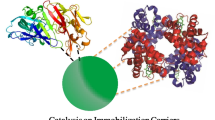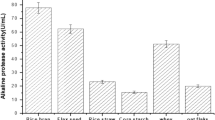Abstract
The production of ethanol by Saccharomyces cerevisiae immobilized cells and its esterification with oleic acid, catalysed by a lipase from Rhizomucor miehei, was the biochemical process considered as model to illustrate the concept of extractive biocatalysis. The selection of the most suitable support for lipase immobilization was carried out. The best results for the ethanol/oleic acid esterification reaction were obtained with the lipase adsorbed on a polyamide type support, Accurel EP 700. The immobilization method was optimized in terms of immobilization pH, contact time and protein/support ratio. The better performances of the extractive fermentations of ethanol were obtained when entrapped k-carrageenan Saccharomyces cerevisiae cells and a lipase from Rhizomucor miehei, free or immobilized in Accurel EP 700, were used simultaneously. The observed reutilization capacity of the immobilized enzyme could be advantageous for its application in a continuous reactor.
Similar content being viewed by others
Author information
Authors and Affiliations
Additional information
Received: 4 July 1996
Rights and permissions
About this article
Cite this article
Oliveira, A., Rosa, M., Cabral, J. et al. Immobilization of Saccharomyces cerevisiae Cells and Rhizomucor miehei Lipase for the Production and Extractive Biocatalysis of Ethanol. Bioprocess Engineering 16, 349–353 (1997). https://doi.org/10.1007/PL00008948
Issue Date:
DOI: https://doi.org/10.1007/PL00008948




